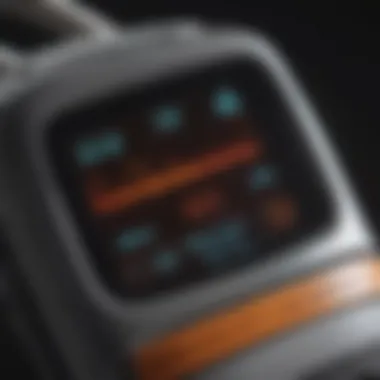Exploring Certified Pulse Oximeters: A Complete Guide


Intro
Pulse oximeters have become critical tools in health monitoring, especially in the context of respiratory conditions and overall wellness. These devices measure blood oxygen levels non-invasively, providing crucial data that can impact treatment decisions and personal health management. Their significance extends across various environments, including hospitals, clinics, and homes. Given the growing importance of monitoring respiratory health, understanding certified pulse oximeters is vital for both health professionals and individual users.
In this detailed guide, we will explore the functionality, types, and wide-ranging significance of certified pulse oximeters. We aim to equip health-conscious individuals with the knowledge necessary to make informed decisions regarding their health and fitness choices. This information will discuss certification processes, factors to consider when purchasing, and how these devices fit into individual health management in both personal and clinical settings.
Features of Certified Pulse Oximeters
Certified pulse oximeters display essential measurement data accurately. Akrrate readings of blood oxygen levels, heart rate, and potentially other factors make these devices useful in tracking overall wellness. It is important to note the differences between clinical-grade and personal-use devices; professionals often rely on the former for critical care.
According to the American Thoracic Society, oxygen saturation below 90% poses risks requiring professional attention. Thus, using a reliable and certified unit can act as an early warning system for users, symbolizing its significance in proactive health management.
Key Considerations When Selecting a Pulse Oximeter
When selecting a pulse oximeter, various features and functionalities come into play. Consider the following:
- Certification and Accuracy: It is crucial that the device carries CE marking or FDA certification. These labels indicate compliance with safety and efficacy standards.
- Display Quality: A clear, easy-to-read display is important for quick assessments. Those with larger fonts or contrasting colors can particularly enhance usability.
- Portability: If regular monitoring is required, a smaller, lightweight model would be advantageous.
- Battery Life: Extended battery life assists in reliable and uninterrupted health monitoring.
Advanced tips: For healthcare professionals, investing in multi-function pulse oximeters that track parameters like perfusion index can strengthen patient assessments, particularly in outpatient or monitoring scenarios.
Clinical Importance of Pulse Oximeters
Pulse oximeters find extensive use in clinical settings—from monitoring patients undergoing anesthesia to enhancing preventive care strategies for individuals at risk of respiratory diseases. The data provided helps detect early changes in a patient's condition, improving responsiveness to health needs.
For chronic disease management such as COPD and asthma, regular checks can guide adjustments in care plans and medications. Pulse oximetry can thus play a critical role not only in real-time monitoring but also in patient education, allowing users to understand the need for prompt intervention in specific situations.
In personal contexts, awareness of one's oxygen levels can motivate lifestyle choices contributing to better overall health, which can be particularly valuable for everyone focused on fitness or well-being.
Each section discussed herein establishes the framework for future topics that will explain in detail the operational principles of these devices and further explore how they can enrich preventive healthcare strategies.
Understanding Pulse Oximeters
Pulse oximeters are essential instruments for monitoring oxygen levels in the blood. To fully appreciate the relevance of certified pulse oximeters, one needs to understand their underlying mechanisms as well as their implications in a health context. As we delve into this subject, it becomes evident that an understanding of pulse oximeters offers insights into their usability, significance, and technical reliability. This background knowledge is crucial for individuals and professionals alike, aiding in the informed selection of devices tailored to specific health needs.
Definition and Functionality
A pulse oximeter is a non-invasive device that measures the saturation of oxygen in a person's blood. It operates based on light transmission and photodetection. The device emits and receives red and infrared light through a body part, commonly a finger or earlobe. The device calculates oxygen saturation by analyzing the ratio of absorbed light that varies based on oxygenated and deoxygenated hemoglobin in the blood.
The functionality of pulse oximeters plays a critical role in various fields, from clinical settings to personal health monitoring. With advancements in technology, pulse oximeters have become increasingly compact but remain accurate. This accuracy is vital for conditions that affect oxygen levels in the blood, such as asthma, pneumonia, and COVID-19.
Medical professionals often rely on this device for quick assessments instead of invasive methods, which require blood samples. Therefore, its non-invasive quality combined with real-time measurements is particularly beneficial in emergency situations.
Importance in Healthcare
The importance of pulse oximeters extends well beyond mere measurement of oxygen levels. They are valuable tools in critical healthcare decision-making. In hospitals, these devices facilitate effective monitoring of respiratory conditions and the overall oxygenation status of patients. Furthermore, understanding how to interpret pulse oximeter readings can significantly influence treatment paths.
Key reasons why pulse oximeters are vital include:
- Rapid assessment: Healthcare professionals can quickly identify patients who need urgent interventions based on low oxygen saturation values.
- Monitoring effectiveness of therapy: Continuous usage can help gauge how well a treatment plan is working, for instance, during oxygen therapy.
- Wide applicability: Their use is not limited to hospitals; they serve functions in home healthcare, occupational health, and sports medicine, empowering individuals to track their daily oxygen needs.
- Experts agree that maintaining an awareness of one’s oxygen levels contributes significantly to overall health management.
“Monitoring your blood oxygen reveals information that can be critical to timely treatments.”
In summary, pulse oximeters are functional devices widely employed in healthcare settings. Understanding their fundamental aspects is the first step for patients, fitness enthusiasts, and health professionals in making informed choices. This knowledge plays a key role in the effective utilization and selection of certified models tailored to specific health goals.
Types of Pulse Oximeters
Understanding the different types of pulse oximeters is crucial for making informed decisions about their use in health monitoring. Each type comes with its own features and advantages. This section paves the way for understanding each variant's specific applications and assessing which meets individual needs best. Awareness of these types enables users to select a device that can enhance their overall health management strategy.
Finger Pulse Oximeters


Finger pulse oximeters are perhaps the most common variant. They are compact and designed to fit on the fingertip. They provide quick and non-invasive measurements. The results are typically displayed within a few seconds. These devices are user-friendly and require minimal training. Patients can easily gauge their blood oxygen saturation levels at home.
With a clear display, these oximeters are perfect for daily use. They often come with an automatic shut-off feature to conserve battery. However, the readings can be influenced by external factors such as nail polish or cold fingers. Its accuracy is crucial, especially for individuals with respiratory issues.
Engaging topics include:
- User Training
- Daily Health Screening
- Common Portable Oximeters like the Zacurate Pro Series 500DL and Wellue BPM-40.
Handheld Pulse Oximeters
Handheld models differ primarily in their design and functionality. These devices are larger and often provide enhanced accuracy compared to their fingertip counterparts. They usually have a more complex display, showing additional data such as pulse rate and plethysmographic waveform. Healthcare professionals favor handheld units in clinical settings due to their robust performance.
Handheld oximeters are equipped with advanced features for comprehensive health monitoring. They may have capabilities to print or transfer data to devices directly, facilitating easy record-keeping. Selecting a device involves considering user interface, and battery life, as some variants require frequent charging.
Advantages of handheld pulse oximeters include:
- More accurate readings under challenging conditions.
- Ability to connect with other health-monitoring devices:
- Users can track information over time.
- For instance, NellcorTM N550BG Handheld Pulse Oximeter
Wrist and Arm Models
Wrist and arm pulse oximeters integrate convenience with functionality. These designs are suitable for users who may not prefer finger or travel-friendly products. They can be worn comfortably throughout daily activities. Users can easily keep contact with their vital signs. These models are often used in athletic contexts and by fitness trainers.
The key feature is 24-hour monitoring. This can provide continuous tracking of oxygen levels during sleep or exercise. Professional athletes utilize this for performance analysis. Some notable examples include:
- *Fingertip Pulse Oximeter and Monitor from Nonin.
- iHealth Air, designed as a versatile tool for fitness enthusiasts.
Smartphone-Compatible Oximeters
Technological advancement enables the integration of pacific features with smart devices. Smartphone-compatible pulse oximeters make health monitoring effortless. Users can connect their oximeters to applications, streamlining data collection into one platform. Tastefully designed user interfaces allow straightforward navigation, improving overall user experience.
These devices can store valuable data over long periods. It also allows users easy access to their historical readings and trends. Health-conscious individuals benefit significantly from continuous insights into their oxygen levels. Some reliable products in this category include:
- Masimo iSpO2 App Compatible Oximeter.
- KardiaMobile Pulse Oximeter, geared towards everyday use.
Equipping oneself with this technology aligns health management initiatives. Device features can attract anyone seeking efficiency in extracting meaningful health data.
In today's fast-paced world, understanding these types enhances your ability to select the perfect pulse oximeter, whether for personal or clinical use.
Certified Pulse Oximeters
Certified pulse oximeters hold a significant position in health monitoring, combining diagnostic value with accessibility for individuals and professionals alike. These devices help measure blood oxygen saturation efficiently, providing critical data about respiratory health. Their role extends beyond just a measure of wellness; they contribute tremendously in a wide range of medical settings.
There's a delineation between general pulse oximeters and their certified counterparts. While both share the same goal of measuring oxygen levels in the blood, certification guarantees that a device has met specific standards set by regulatory bodies. This ensures reliability and precision in readings, that are fundamental in clinical environments and home monitoring.
Standardization brings confidence, especially in critical care situations where accurate readings can influence treatment paths. For individuals managing chronic conditions or athletes monitoring performance, certified oximeters offer more than superficial insights into health; they provide a deeper understanding that can lead to better-informed health decisions.
The benefits of using certified pulse oximeters include:
- Enhanced accuracy in measuring blood oxygen levels
- Compliance with health and safety regulations
- Greater trust among healthcare providers and patients
- Access to warranty and customer support services
In contrast, non-certified devices may yield unreliable results, potentially leading to health risks. Thus, emphasizing the importance of getting certified devices cannot be understated. This belonging to a reputable regulation not only safeguards the user but inspires trust in the healthcare mechanism as a whole.
What Does Certification Mean?
Certification refers to the process through which a pulse oximeter is assessed against established industry standards, confirming its measurement accuracy and reliability. This ensures that the device has undergone thorough testing. It complies with the benchmarks and performance metrics meant to guarantee safety and efficacy in operation. When a manufacturer claims that their product is
How Pulse Oximeters Measure Oxygen Levels


Pulse oximeters serve a critical role in monitoring oxygen saturation in blood. This section explores the mechanics behind their function and underscores factors impacting their accuracy. Understanding these elements is crucial for health professionals and individuals seeking reliable health data.
The Science Behind Pulse Oximetry
At its core, pulse oximetry measures the light absorption characteristics of oxyhemoglobin versus deoxyhemoglobin. When light, typically a red and infrared wavelength, passes through a translucent part of the body—often a fingertip—the oximeter can estimate the amount of oxygen bound to hemoglobin in the blood. Generally, as the arterial blood fills with oxygen, it reflects more infrared light. Conversely, deoxygenated hemoglobin absorbs more light.
The operating principle largely relies on the Beer-Lambert Law, which articulates the relationship between light absorption and the concentration of the substances in the path of the light. This allows pulse oximeters to deliver non-invasive measurements, providing instant feedback about a patient’s oxygen saturation levels.
Overall, accuracy in measuring oxygen levels is achieved through sophisticated algorithms that incorporate multiple signals from the light sensors. Rundown due to factors like motion or ambient light interference affects the oximeter’s performance. Thus, technicians administering this technology need to ensure optimal conditions for best results.
Factors Affecting Readings
Several environmental and physiological conditions influence the readings given by pulse oximeters. Understanding these factors can ensure more accurate outcomes—imperative for health assessment. Key influences include:
- Peripheral Circulation: Poor blood flow to the fingers can lead to underestimations of oxygen levels. Cold conditions may constrict blood vessels, impacting the accuracy.
- Skin Pigmentation: Studies have indicated that darker skin tones may determine the reflectance and absorption of light, leading to potential variability in oxygen saturations measured.
- Movement: Sudden movements or shivering can introduce noise in blood flow measurement, generating unstable readings.
- Nail Polish or Artificial Nails: Opaque colors can obstruct the sensor function, providing erroneous results.
- Altitude Changes: Because of low atmospheric pressure at higher altitudes, oxygen saturation values can appear lowered even under healthy conditions.
Altitude can create significant variations in pulse oximeter readings, even with unchanged physiological conditions. It is crucial to take these factors into account in health assessments, particularly for athletes or individuals living in mountainous regions.
By considering these elements, medical and fitness professionals can make informed decisions based on pulse oximeter outputs. Acknowledging potential limitations ensures appropriate reactions to the measurements obtained from these central health devices.
Choosing the Right Pulse Oximeter
Selecting an appropriate pulse oximeter is a significant decision that can impact health monitoring effectively. It bears importance due to the varied purposes for which these devices are used. Certain features enhance usability and accuracy. Understanding these features leads to informed decisions. This section outlines crucial elements beneficial while making this choice. By focusing on key aspects, users can obtain devices that best meet their needs.
Key Features to Look For
When choosing a pulse oximeter, several essential attributes should guide your decision. Recognizing what these features entail is vital:
- Accuracy: Ensure the device demonstrates consistent and precise readings. Certified models usually possess superior accuracy.
- Display Type: A clear and bright display improves readability under various lighting conditions. Consider options like color screens for added clarity.
- Battery Life: A long-lasting battery supports extended use, particularly in clinical or outdoor settings.
- Portability: Lightweight devices facilitate convenience, particularly if used in travel or sports.
- Data Logging: Check if the oximeter can store previous readings. This feature aids in tracking oxygen levels over time.
By focusing on these key features, individuals and professionals can utilize pulse oximeters more effectively.
Price Considerations
Price plays a major role in the selection of a pulse oximeter. Financial aspects matter but compromises should not be made on the device's quality.
- Budget: Establish a fixed budget. Considering certified models from brands like Masimo or Nonin is beneficial since they often ensure quality. A lower price does not guarantee reliability.
- Importancy vs. Cost: Evaluate how crucial regular monitoring is for health before limiting options based solely on price.
- Note on Lifespan: Consider potential long-term savings of investing in a device based on durability rather than commit to cheaper, less reliable devices.
Taking into account these price variables ensures a well-rounded approach towards purchasing a pulse oximeter.
User Reviews and Recommendations
Reviews and recommendations are instrumental in establishing the reliability of a pulse oximeter. Experiences from actual users provide insights often overlooked in marketing material.
- Credibility of Reviews: Search for reviews on reliable platforms like Amazon and Reddit. Verify whether the feedback is balanced and includes various perspectives, both positive and negative.
- Community Recommendations: Engage with online health forums where professionals share experiences. Practitioners often provide invaluable recommendations based on their expertise.
- Real-World Testing: If possible, it might help to test different models in-person. Checking electronic stores and seeking guidance also is good practice.
By Imbedding user experiences, evaluations of devices become more effective, leading to smarter consumer choices.
So, consider user insights, pricing metrics, and essential features before choosing a pulse oximeter. Making a well-informed decision leads to enhanced oxygen tracking, which supports improved health management.
Applications of Certified Pulse Oximeters
The relevance of certified pulse oximeters extends beyond their basic function of measuring blood oxygen levels. Their applications influence various fields, particularly in clinical environments, at-home health monitoring, and within sports and fitness contexts. Each application demonstrates distinct advantages along with critical responsibilities for users in these scenarios. Understanding these elements ensures that individuals are prepared to utilize pulse oximeters effectively and knowledgeably.
In Clinical Settings
Pulse oximeters play a significant role in clinical settings. They are standard diagnostic tools in hospitals, enabling healthcare professionals to quickly assess a patient's oxygen saturation levels. Consistent monitoring can be crucial for patients suffering from respiratory diseases, such as chronic obstructive pulmonary disease (COPD) or asthma.
Here, usage is not just about the readings obtained but also about learning the trends. Medical staff can utilize real-time data to make informed decisions regarding treatment plans. The convenience and accuracy of certified oximeters allow for safer patient management. With precise readings, medical teams can respond promptly to changes in a patient's condition, optimizing care.


"Accurate readings from certified pulse oximeters can significantly affect patient outcomes in critical environments."
Integrating these devices into routine assessments generates vital data. Moreover, regulatory approval ensures that the devices maintain the highest accuracy standards, instilling trust in their usage among clinicians and other healthcare providers.
At Home Health Monitoring
With advances in technology, many people now own certified pulse oximeters for home health monitoring. The ability to monitor oxygen levels at home fosters a better understanding of one's own health. This is especially true for individuals living with chronic health conditions or those concerned about their respiratory function.
The importance of regular monitoring cannot be overstated. At-home usage offers several benefits, including:
- Convenience: Frequent checks can be performed without the need to visit a clinic, allowing for proactive health management.
- Early Detection: Monitoring oxygen levels can help identify respiratory issues before they worsen, allowing timely medical intervention.
- Cost Savings: It may reduce frequent clinic visits, resulting in lower healthcare costs over time.
While using a pulse oximeter at home is beneficial, users should understand limitations, as misleading readings can happen, sometimes due to improper use or outer factors. Proper education and guidance on reading and interpreting measurements remain vital.
Usage in Sports and Fitness
In the sport and fitness community, certified pulse oximeters have found an enthusiastic following. Athletes who are involved in high-endurance training often rely on these devices to optimize their performance and monitor their oxygen consumption.
The benefits in this domain are numerous, including:
- Performance Insights: Monitoring oxygen levels can help athletes determine how efficiently their bodies consume oxygen during workouts.
- Training Optimization: Understanding oxygen saturation levels during specific drills can assist trainers in adjusting intensity based on individual needs, creating personalized training templates.
- Safety Monitoring: For athletes participating in high altitudes or intensive conditioning sessions, using a pulse oximeter can aid in detecting performance drops or harmful oxygen levels before they evolve into serious concerns.
Awareness of how training impacts oxygen levels can empower athletes. Knowledge gained through consistent monitoring translates into more informed training decisions, safety awareness, and overall improved health and performance. Incorporating an oximeter into fitness routines has evidently enhanced personal health management.
The diverse applications of certified pulse oximeters underscore their significant role in various contexts. Whether in clinical setups, everyday life for home users, or among performance-driven athletes, these devices enhance decisions concerning health management and have the potential to improve outcomes substantially.
Limitations of Pulse Oximeters
Pulse oximeters are invaluable tools for monitoring oxygen levels in the blood. However, they do have their limitations. Understanding these constraints is essential for accurate usage in both clinical and home settings. Misinterpretation of readings could lead to unnecessary anxiety or misguided health decisions. It is crucial for users to be aware of factors affecting accuracy and reliability.
Potential Sources of Error
When using pulse oximeters, several sources of error can affect readings. Common issues include:
- Poor Circulation: Reduced blood flow due to peripheral vascular disease can yield inaccurate readings.
- Nail Polish or Artificial Nails: These can interfere with light transmission, skewing data. Light must pass effectively through the nail to get correct readings.
- Movement: If a patient or user moves during the reading process, it can cause the device to misread circulatory levels.
- Skin Pigmentation: Studies show skin color may affect the performance of some devices, leading to discrepancies in the found blood oxygenation levels.
- Illness or Skin Conditions: Conditions like cold hands can complicate accurate readouts, leading to the representation of lower saturation.
It is advisable for users to consider these factors when interpreting their results. Knowing these aspects can improve both understanding and implementation of pulse oximeter technology.
Not a Diagnostic Tool
It's critical to note that pulse oximeters are not medical diagnostic devices. They provide vital information about oxygen levels but do not diagnose conditions. Healthcare professionals must use them as preliminary assessment tools and not substitutes for comprehensive evaluations. Oxygen saturation readings from a pulse oximeter can indicate potential concerns, but further testing is usually needed.
In summary, rely on pulse oximeters as monitoring tools rather than definitive medical assessments.
Awareness about their limitations fosters informed decisions. Always consult healthcare professionals following abnormal findings for a thorough assessment. Pulse oximeters serve a useful role, but balancing their use with caution is essential.
The End
Monitoring oxygen levels plays a crucial role in personal and clinical health management. Pulse oximeters serve as fundamental tools, providing vital information about the body's oxygen saturation and overall respiratory condition. Understanding their importance is essential for informed health decisions.
The Value of Monitoring Oxygen Levels
The significance of tracking oxygen levels extends beyond a mere routine check. Low blood oxygen can indicate various medical issues, from respiratory problems to potential circulatory conditions. For health professionals, assessing oxygen levels can be vital in diagnosing and managing patient care.
Individuals using pulse oximeters receive immediate feedback, which can affect daily activities and long-term health goals. For example, athletes can monitor their oxygen saturation levels to optimize performance during training sessions. This real-time data allows for informed choices aligned with their physical demands.
Proper monitoring also assists in managing chronic conditions, particularly for those with COPD or asthma. Maintaining oxygen saturation above desired thresholds can signify effective disease management and lead to earlier interventions in the event of complications. Accordingly, consistent use of certified pulse oximeters can empower individuals to take a proactive approach to their well-being.
Empowering Personal Health Decisions
Making informed choices about health is increasingly significant in today’s climate. Certified pulse oximeters bolster awareness regarding oxygen levels and can unveil underlying health issues. With direct access to relevant data, individuals are more capable of engaging in conversations with healthcare professionals about their respiratory and overall health.
Moreover, understanding readings from certified devices promotes greater accountability for personal health decisions. Some studies suggest that patients who actively track their health metrics—including oxygen saturation—exhibit better health outcomes compared to those who do not.
This empowerment is twofold: users not only gain insight into their conditions but also take ownership of their health journeys. As individuals self-manage conditions and consult with healthcare providers, they contribute positively to their health narratives. By utilizing a certified pulse oximeter, the user combines technology with surveiling of vital signs, bridging competence and accessibility in health management.







